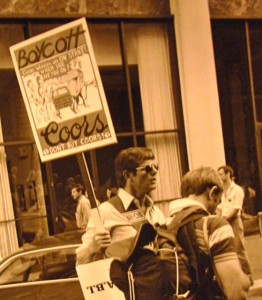The Bay Area’s vibrant heritage of queer community is matched by a long and powerful history of labor organizing. Labor/ gay connections hearken back to the mid-1930s, when the Marine Cooks and Stewards Union organized men and women who cooked and served meals and tended passenger cabins on luxury cruise ships that plied the South Pacific. Union members were gay and straight, African-American, Asian and white. “No race-baiting, red-baiting or queer-baiting” was the union’s radical creed.
The postwar red scare destroyed the MCS, but members survived. Some men found jobs tending bar and cooking in cafes along the waterfront, and others worked on the docks. In other parts of the city, semi-secret homophile groups were starting up: the Daughters of Bilitis was founded by lesbians in 1955, and the Mattachine Society for men arrived in 1956. Although labor was not a topic, union members were in those groups.
 Gay liberation opened a new and brilliant queer scene, especially in the Castro. In 1973, Harvey Milk was among thousands of gay male migrants seeking a better life. He tried gay community politics but found his first luck with beer truck drivers Local 888 of the Teamsters. Allan Baird, a local off icer and a longtime homeowner in the neighborhood, was building a campaign to boycott Coors beer and its Bay Area distributors. Baird had already enlisted African-American, Arabic and Chinese grocers by highlighting Coors’ racial hiring practices. Baird asked Milk to help him with the Castro gay bar scene.
Gay liberation opened a new and brilliant queer scene, especially in the Castro. In 1973, Harvey Milk was among thousands of gay male migrants seeking a better life. He tried gay community politics but found his first luck with beer truck drivers Local 888 of the Teamsters. Allan Baird, a local off icer and a longtime homeowner in the neighborhood, was building a campaign to boycott Coors beer and its Bay Area distributors. Baird had already enlisted African-American, Arabic and Chinese grocers by highlighting Coors’ racial hiring practices. Baird asked Milk to help him with the Castro gay bar scene.
Coors was using polygraph tests to screen out gay job applicants, but the Tavern Guild, an association of gay bars, would not endorse Milk’s boycott bid. Then, early in 1974, a new organization showed up: Bay Area Gay Liberation. Howard Wallace, a founder, invited Baird to speak at one of BAGL’s first meetings. That gathering—and every other meeting for months to come—concluded with BAGL activists congregating at bars that still sold Coors with leaflets, rowdy chants and persuasive denunciations.
Throughout the nation, right-wing movements rose to block queer progress, but where labor was strong they rarely succeeded. California’s unionists understood that efforts to repeal standing gay rights ordinances, or to enact new restrictions on employment, were harsh for individual gay workers as well as disruptive to collective bargaining.
In 1978, State Senator John Briggs sponsored Proposition 6 as an amendment to California’s constitution; the amendment would “protect children” by firing queer school workers and their straight allies. Californians joined the fight in big cities and in rural towns and brought their unions, their liberal churches and their civil rights and community organizations into the fray. Labor got out the vote during the final weeks, including a front-page “Vote No” endorsement in the statewide AFL-CIO newsletter and volunteer-staffed phone banks and more volunteers to hand out 2.3 million advisory palm cards on election day at the polls. Proposition 6 failed by 58 percent.
Gay/labor projects of the 1980s focused on direct needs and pragmatic solutions that could be replicated by other workplace activists. One remarkable development was the sustained work of the AIDS committee of Service Employees Local 250, which represented hospital workers in San Francisco facilities. By 1983, these hospitals and clinics were at the epicenter of the AIDS crisis.
In 1984, the AIDS committee produced “AIDS and the Health Care Worker,” a simple fact sheet that explained safe practices and summarized what little was then known about the growing epidemic. SEIU expanded the booklet and between 1984 and 1987 distributed it nationally through five editions, including a Spanish-language version. By offering important, life-saving guidance about AIDS in the hospital workplace, the project modeled good sense and deliberate self-care during dangerous times.
These are just a few Bay Area labor stories from Out in the Union. Readers will find an entire chapter about union drives at Bay Area cafes, hotels, and small businesses and social service centers owned or managed by LGBT people, from the Patio/Bakery café in the Castro (1979–80) and continuing to the unionization of the San Francisco AIDS Foundation through two contract cycles (1994–2001).
Miriam Frank will read from her book “Out in the Union: A Labor History of Queer America” (now out in paperback from Temple University Press) at two area events at Laurel Bookstore, 1423 Broadway, in Oakland at 6:00 pm on Thursday April 23 and Modern Times Bookstore, 2919 24th Street in San Francisco at 3:30 pm on Saturday April 25.
Recent Comments